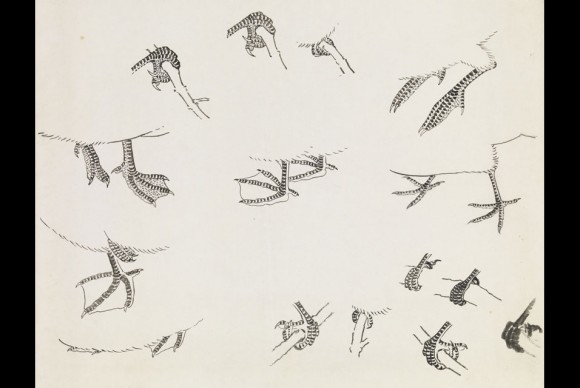How Did Chinese Artists Learn and Practice Their Craft?
NEW YORK, NY.- A new installation at The Metropolitan Museum of Art, Mastering the Art of Chinese Painting: Xie Zhiliu (1910-1997), demonstrates how Chinese artists learned, historically, from earlier masterpieces and from nature. It showcases more than 100 works—including paintings, sketches, drawings, calligraphies, and poetry manuscripts—by Xie Zhiliu (pronounced “shay jer leo”), one of modern China’s leading artists and connoisseurs. It also marks the 100-year anniversary of his birth. A number of his sketches and copies will be accompanied by photographs of earlier works that inspired him and by his own completed works, in order to trace how he developed his unique style. Drawn primarily from a recent gift to the Metropolitan Museum from the artist’s daughter Sarah Shay, the works on view comprise the first solo exhibition of Xie Zhiliu’s works to be organized outside China.
“The field of Chinese painting is singularly lacking in examples of how traditional artists practiced their craft,” said Maxwell K. Hearn, Douglas Dillon Curator in the Museum’s Department of Asian Art. “This rich body of material provides a unique resource for studying one major artist’s creative process in detail. Chinese paintings are often the freehand creations of master draftsmen who wielded a brush with confidence borne of years of practice. But Xie’s preparatory drawings reveal another set of methods, in which a seemingly spontaneous work was often preceded by one or more sketches and a finished draft that could serve as a template for the final composition. Liberated from the need to visualize the completed work in advance, Xie was able to concentrate on making his brushstrokes in the finished work as dynamic and beautiful as possible.”
Xie Zhiliu was a native of Changzhou, a city with a strong tradition of bird-and-flower painting, a genre in which Xie excelled. Moving to Chongqing to escape the Japanese occupation in 1937, he became a close friend of renowned painter Zhang Daqian (1899-1983), who introduced him to the Buddhist cave murals of the Silk Road oasis of Dunhuang. After the war, he became an advisor and preeminent connoisseur on painting and calligraphy for the Shanghai Museum as well as a professor of painting. Due to his access to the rich holdings of the museum, which enabled his close study of Tang, Song, and Yuan dynasty painting (a topic on which he published), Xie expanded his style. Between 1983 and 1990 he led a team of scholars in evaluating the collections of China’s leading cultural institutions, a project that resulted in a 24-volume illustrated index of more than 70,000 paintings and calligraphies.
The installation will be divided thematically. The first two galleries, entitled “Tracing the Past,” present Xie’s early studies of figures, narratives, and bird-and-flower paintings of the Song dynasty (960-1279). His sketches of Buddhist figures based on his study of the Dunhuang murals are also included here. In the two galleries that follow, Xie’s admiration for the master painter Chen Hongshou (1599-1652) and other bird-and-flower specialists is highlighted through a number of Xie’s precise copies of these artists’ paintings.
How Xie learned directly from nature will be illustrated in the fifth gallery. A number of studies of flowers and fruit will be featured, along with two groups of landscape sketches, capturing naturalistic compositions defined largely by contour lines with little interior modeling. Also on view in this section will be a pencil and ink sketch of a narcissus visualized from different angles, a work that shows how his lines were formed slowly and involved numerous adjustments and corrections.
Xie’s appreciation for cursive calligraphy is the focus of the next section. A manuscript called Poems of Inner Mongolia (1961), as well as several copies including Select Characters from Huaisu’s Autobiography of 1969 and Notes on Zhang Xu from the late 1960s—before the darkest period of the Cultural Revolution—document Xie’s conscientious study of ancient models in the Shanghai Museum collection. The section ends with Five Poems (1990), which reflects the abiding influence of these earlier masters. And, the final gallery will feature Xie’s integration of naturalism and stylization in his late years. Among the works on view will be a brightly colored album called Views of Yosemite National Park, California (1994), which the artist made with his wife, the painter Chen Peiqiu (b. 1923), in 1994.
Complementing the installation will be a display of some of the artist’s seals, which constitute a valuable anthology of the seal carver’s art by many of the leading practitioners of the late 20th century. This group also highlights one of the most innovative and important forms of calligraphy practiced since the late Ming dynasty.
Related posts:
- ArtSpace/Virginia Miller Galleries Showcasing Contemporary Chinese Artists
- Rotation at The Nelson-Atkins Museum of Art Features Seminal Chinese Painting
- Christie’s Presents the Most Valuable Chinese Painting Ever Offered at Auction
- Rare Opportunity to View Seminal Event in the History of Chinese Painting
- Contrasts Gallery to Exhibit Six Prominent International Artists at Art Taipei

